Bruce The Great White Shark, a free knitting pattern from Knitty.com. Free knitting pattern for a DETAILS HERE.
INTRODUCTION
Bruce The Great White Shark
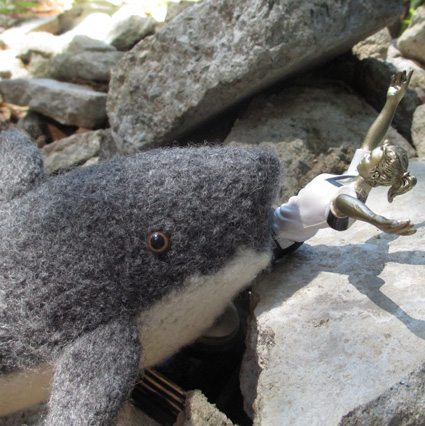
![]()
For those of you too young to remember, 'Bruce' was the movie-set name of the mechanical shark that was used in filming the original 'Jaws' movie. He sank a lot.
Bruce is a knitted and felted great white shark. Once completed, he measures about 12 inches/30.5 cm long.
If made for a child, Bruce should be a room decoration only until age 3, or past the 'everything in the mouth' stage.
 photos: Frances Gillespie
photos: Frances Gillespie
SIZE
One
FINISHED MEASUREMENTS
After felting, Bruce will be about 12 inches/30.5 cm long
MATERIALS
Yarn
Patons Classic Wool [100% wool; 210 yd per 100g skein]
![]() [MC] Dark Grey Mix; 1 skein
[MC] Dark Grey Mix; 1 skein
![]() [CC1] Aran; 1 skein
[CC1] Aran; 1 skein
![]() [CC2] Grey Mix; a few yards
[CC2] Grey Mix; a few yards
Recommended needle size
[always use a needle size that gives you the gauge listed below - every knitter's gauge is unique]
![]() US #9/5.5mm needles for working flat
US #9/5.5mm needles for working flat
![]() US #9/5.5mm needles for working small circumference in the round
US #9/5.5mm needles for working small circumference in the round
Note: DPNs are recommended for ease of working small rounds, and for sections worked flat with small numbers of stitches.
Notions
![]() stitch holders or waste yarn
stitch holders or waste yarn
![]() a length of waste yarn
a length of waste yarn
![]() stitch markers
stitch markers
![]() pair of 9mm brown animal safety eyes
pair of 9mm brown animal safety eyes
![]() polyester stuffing
polyester stuffing
![]() yarn needle
yarn needle
![]() regular sewing needle, thread
regular sewing needle, thread
GAUGE
Gauge is not critical but should be loose to allow for shrinkage during felting.
Sample gauge pre-felting was 14 sts/18 rows = 4 inches/10cm.
PATTERN NOTES
[Knitty's list of standard abbreviations and techniques can be found here.]
Techniques:
- Intarsia
- Lifted Increases:
- RLI (Right Lifted Increase): Insert the right needle into the stitch below the next stitch on the left needle. Pick up this stitch and place it on the left needle, then knit into it. 1 stitch has been increased.
- LLI (Left Lifted Increase): Use the left needle to pick up the stitch 2 rows below the last stitch on the right needle. Knit into this stitch. 1 stitch has been increased.
CHARTS
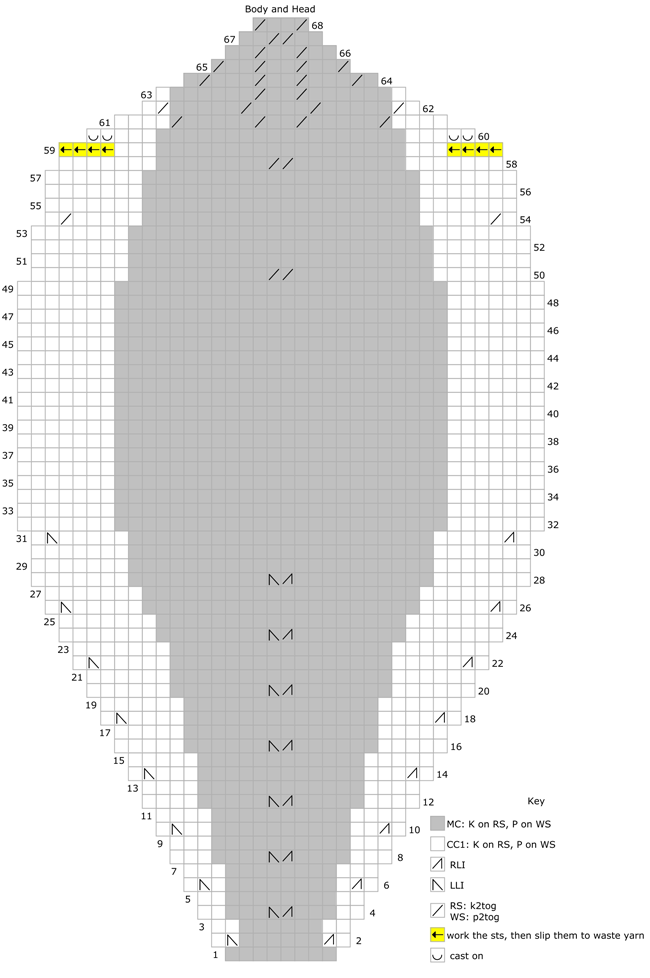
DIRECTIONS
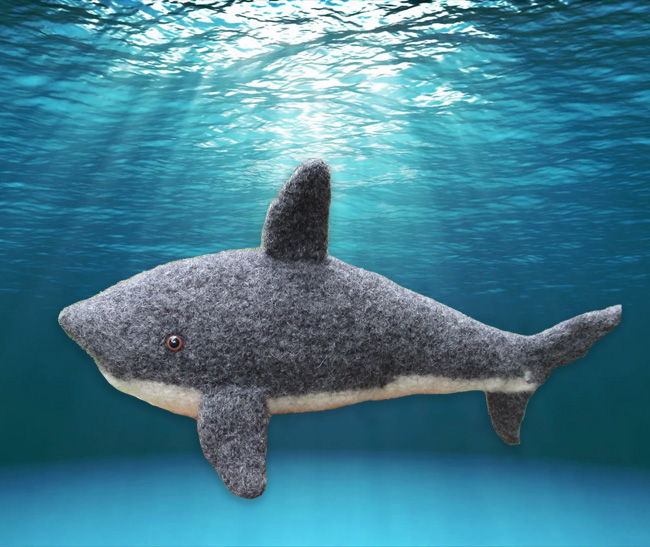
BODY (beginning at tail end)
Using needles for working flat and CC2, CO 8 sts.
Work from chart, using intarsia method. Chart is worked in stockinette stitch, and starts with a WS (purl) row.
When chart is complete, 4 sts rem.
Break yarn leaving a tail; thread onto needle and pull through last 4 st to gather for nose. Your shark should now look like Figure 1.

The middle of the work is the spine; the edges will form the belly seam.
Fold body in half lengthwise, wrong sides together.
Turn shark upside down and return these sts to a needle – a single DPN is recommended if you're using them.
These stitches will be used to make the lower jaw (see Figure 2).

LOWER JAW
With RS facing, attach CC1 and continue on those 8 sts, working flat
Row 1 [RS]: K3, k2tog, k. 7 sts.
Row 2 [WS]: (P1, p2tog) twice, p1. 5 sts
Row 3: K2tog, k1, k2tog. 3 sts.
Row 4: P3tog. Cut yarn and pull through st to secure, leaving a 12-inch/30cm tail for seaming.
Using CC1, loosely seam shark's belly closed, leaving a 1.5 inch/4cm gap for stuffing mid-belly.
Shark underside should now appear as in Figure 3.

With a darning needle and MC yarn, thread through the 8 cast on stitches to gather and fasten off the tail end.
Thread a piece of contrasting waste yarn down the middle of the shark's back; this will mark the spine and make placement of tail fins easier.
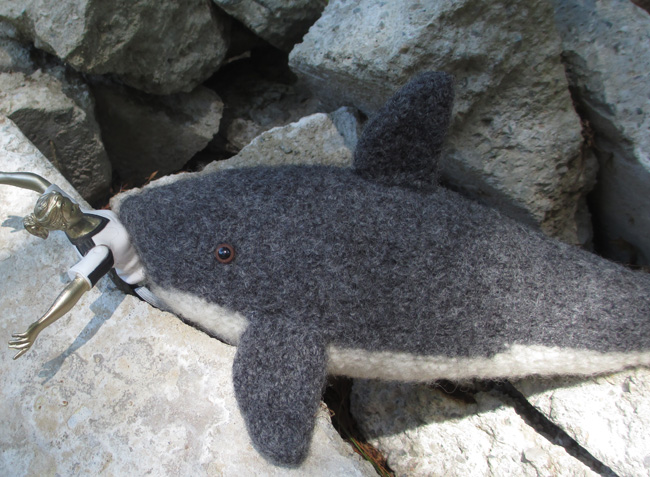
TAIL FIN, TOP HALF
With MC and needles for small circumference in the round, pick up and knit 7 sts from tail tip going up spine towards nose, just outside the spine marker yarn. Turn. With a second needle, pick up 7 sts on other side of spine (in the nose to tail direction). 14 sts. Join for working in the round.
Rounds 1–2: Knit.
Round 3: K2, k2tog, k6, k2tog, k2. 12 sts.
Rounds 4–5: Knit.
Round 6: K1, k2tog, k6, k2tog, k1. 10 sts.
Round 7: Knit.
Round 8: (K2, k2tog) twice, k2. 8 sts.
Round 9: Knit.
Round 10: K1, k2tog, k2, k2tog, k1. 6 sts.
Round 11: K2tog, k2, k2tog. 4 sts.
Round 12: K2tog twice. Cut yarn and pull through 2 final sts to secure.
TAIL FIN, BOTTOM HALF
With MC and needles for small circumference in the round, pick up and knit 6 st from tail tip going up center of belly towards nose. Turn. With a second needle pick up 6 st headed back to tail tip. 12 sts.
Join for working in the round.
Round 1, 2: Knit.
Round 3: K1, k2tog, k to last 3 sts, k2tog, k1. 2 sts decreased.
Round 4: Knit.
Repeat the last 2 rounds until 4 sts rem.
Final round: K2tog twice. Cut yarn and pull through 2 final sts to secure.
Tail will now look as in Figure 4.

DORSAL AND SIDE FINS [Make 3]
With MC and needles for working flat, CO 16 sts.
Row 1 [RS]: Knit.
Rows 2, 4, 6, 8, 10 [WS]: Purl.
Row 3: (K4, k2tog) twice, k4. 14 sts.
Row 5: K3, k2tog, k4, k2tog, k3. 12 sts.
Row 7: K4, k2tog twice, k4. 10 sts.
Row 9: (K2, k2tog) twice, k2. 8 sts.
Row 11: K2, k2tog twice, k2. 6 sts.
Row 12: P1, p2tog twice, p1. 4 sts.
Break yarn leaving long tail, thread onto needle, pull through last 4 st to form fin tip (Figure 5A).

Fold fin in half wrong sides together, loosely seam all edges (Figure 5B). Attach dorsal fin to spine, and two side fins to side of body using needle and matching yarn, using Figure 6 as a guideline for fin placement.

MOUTH LINING
With CC2, CO 1.
Row 1 [RS]: Kfb. 2 sts.
Row 2, 4, 6, 8 [WS]: Purl.
Row 3: Kfb, k1. 3 sts.
Row 5: K1, kfb, k to end. 4 sts.
Row 7: K2, kfb, k to end. 5 sts.
Rows 9, 11, 13 [RS]: Knit.
Row 10: P1, p2tog, p2. 4 sts.
Row 12: P1, p2tog, p1. 3 sts.
Row 14: P1, p2tog. 2 sts.
Row 15: K2tog. Cut yarn and pull through st to secure, leaving a 12 inch/30cm tail for seaming.
This will form a diamond shaped piece to insert into the mouth as a lining. Fold in half and tuck inside the mouth with right side out, and seam loosely to the upper and lower jaw. Finish closing the seam up to the nose tip with matching yarn. See Figure 7 for how the shark's nose and mouth should look.

FINISHING
Fasten off all yarn ends. You are now ready to felt Bruce. Place him in a mesh bag in your washing machine; set on extra small load and hot water, and add a tiny pinch of laundry detergent. Start the machine.
Check every five minutes or so until Bruce reaches the desired level of felting. (Be careful not to let Bruce go through the spin cycle or he may get creases). Remove him from the bag, loosely stuff him with newspaper and set him somewhere warm to dry. When he is dry, remove the newspaper and attach the safety eyes, using photos as a guide for placement. Stuff him firmly with polyester filling, and sew him shut with matching thread. You may also need to secure any seams with needle and thread that did not completely close during felting.
ABOUT THE DESIGNER
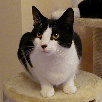 Frances is a longtime knitter who branched out into felting about 15 years ago. She's fascinated with the process of designing the unusual, weird, and unloved critters.
Frances is a longtime knitter who branched out into felting about 15 years ago. She's fascinated with the process of designing the unusual, weird, and unloved critters.
She can be contacted here or found on Ravelry.
Pattern & images © 2018 Frances Gillespie.